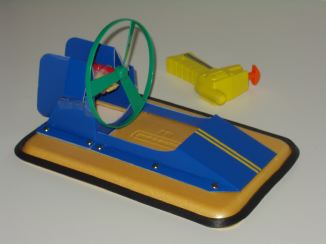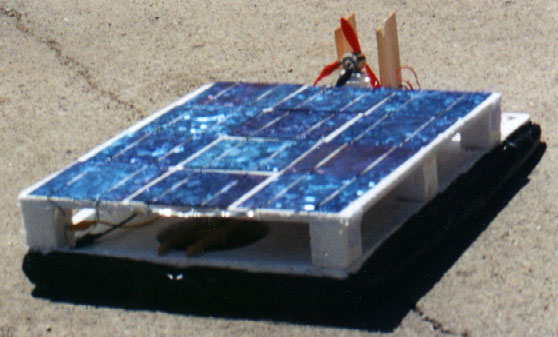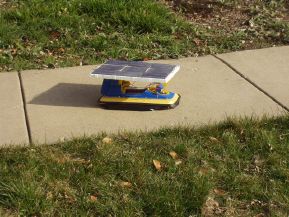Alternative Power Sources
"In the late 90s, I experimented with a number of different ways to power a model hovercraft. I ultimately decided that battery powered crafts were the best all around solution, but batteries do have drawbacks -- namely they are heavy and take a long time to charge if you don't have a special charger. To see what the alternatives to batteries were, I built hovercraft powered by flywheels, compressed air engines, rubberbands, balloons, CO2 cartridges, CO2 powered engines, and solar power. Adding alternative sources of power was easy --except for solar power, each power source came from a previously existing broken toy airplane. The hard part was making each hovercraft to try out my ideas. Also, because no two model hovercraft that I built were the same, it wasn't always clear how to compare one hovercraft with another. Now, with the GH line of model hovercraft kits, building the hovercraft testbed is easy. Instead of worrying about how to build the hovercraft, you can concentrate on how to creatively power it. When trying out different options, it is now easy to change just one thing at a time while keeping all other aspects of the hovercraft the same for a fair comparison. " -- Eric Goldstein
Here are some ideas to get you started, but remember, there are lots of possibilities out there!
A rubberband powered GH-1 hovercraft


A rubberband powered hovercraft is fun -- wind it up and it flutters away. Use the parts from one of those inexpensive rubberband powered airplanes you find at toy stores, or buy special parts at a hobby store. Hovercraft designs with multiple propellers are certainly do-able.
A flywheel powered GH-1 hovercraft



You've seen flying toys like the one shown above -- pull the cord and the toy is launched into the air. You can take toys like these apart and stick them onto your hovercraft with a little hot glue (easy to peel off later). The performance of this craft wasn't all that amazing, but then again, the helicopter never flew very well either. Certainly one was no worse than the other!
A compressed air engine GH-1 hovercraft


Various toy companies (including SpinMaster's original product, parts of which are shown here) now sell airplanes and other toys that run using an engine powered by compressed air. Pump them up, and they'll roar away with a quick burst of power and then settle back and putter on for a little while. Many toy airplanes are designed so that the wings can be removed - in this case, the entire body of the airplane including the air tank, engine, and propeller can be attached to your hovercraft with velcro.
Using all these airplane toys kind of makes you wonder what happens if you leave the wings on when you attach airplane parts to a model hovercraft ...well, that's for a future section of the webpage!
All of the above options make the same tradeoff -- charging them up takes very little time, but they also run for a very short time.
But there is a way for a hovercraft to run all day, and you never have to charge it up....
A solar powered GH-2 hovercraft


A model hovercraft that will run for hours! These models may not be very fast
or powerful, but they are a whole lot of fun and the nearly unlimited run time makes them a joy to use. A solar power craft's
performance is much better when the sun is high in the sky, and needless to say, they only work on clear days.
Watch out for shadows!
The craft pictured on the left was built in 1999 and worked great. Although it looks a bit odd, it is similar "under the hood" to the GH-2 hovercraft. The craft was radio controled - the RC gear was standard RC car equipment. The craft shown on the right is a GH-2 with a solar panel attached on top. The best design for this craft is still being worked out, but it is clear that a solar panel need not weigh more than the GH-2's regular batteries, and using modern solar cells, it should be able to deliver nearly as much power as batteries in the midday summer sun.
A complete solar powered hovercraft kit is in development. Interested? Don't delay buying a GH-2 or GH-C kit because you're waiting for a solar version to come out. A "Solar upgrade" to the GH-2 and GH-C kits will be made available for those who already own a GH-2 or GH-C.
What's the delay? Well, Goldstein Hovercraft, LLC is located in the Chicago suburbs, approximately on the 42nd northern line of latitude. At this latitude, the sun is so low in the winter sky that solar panels pointed straight up generate less than half the power that they do in the summer. Designing a craft that works well during the Chicago winter is possible, but such a craft would be quite expensive, and probably so large that it wouldn't be practical. It makes more sense to build a reasonably sized craft that works well during the sunny time of the year and in places that are sunny year round. Several designs have been built and await either the springtime or a, ahem, "research trip" to a tropical locale for proper testing.
You can figure out the difference in power between summer and winter at your locale if you know a few facts and a little trigonometry. First, you need to know that the earth tilts 23 degrees toward the sun in the summer, and 23 degrees away from the sun in the winter. So, the sun's angle away from straight up is your latitude in degrees + 23 degrees in the winter, and your latitude - 23 degrees in the summer. In Chicago, that's 42 degrees latitude +23 degrees = 65 degrees in winter, and 42 degrees - 23 degrees = 19 degrees in sumer. Now we need to know that the sun, if directly overhead, delivers 1400 watts per square meter. So, that means that the energy delivered to a solar panel pointed straight up is approximately 1400 watts per square meter mulitplied by the cosine of the sun's angle away from straight up. For example, in Chicago, in the summer, a solar panel receives 1400 watts per square meter * (cos 19 degrees ) = 1324 watts per square meter, while in the winter, a solar panel receives 1400 watts per square meter *(cos 65 degrees) = a mere 591 watts per square meter. Of course, even 591 watts per suqare meter sounds like a lot, but the GH-2 isn't anywhere near that big, and unfortunately, currently available solar cells are only 12% to 14% efficient. Once the design for the GH-Solar kit is finalized, its power requirements will be posted here so that you can figure out how well a solar powered hovercraft will work at different times of the year at your location.
© Goldstein Hovercraft, LLC










